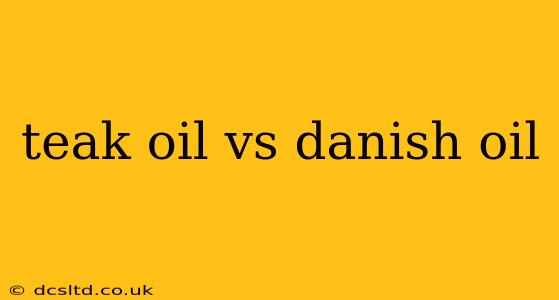Choosing the right oil for your wood finishing project can be tricky. Two popular options often leave woodworkers wondering: teak oil and Danish oil. While both offer protection and enhance the beauty of wood, they differ significantly in composition, application, and final result. This comprehensive guide will clarify the key distinctions between teak oil and Danish oil, helping you make the informed decision for your next project.
What is Teak Oil?
Teak oil, despite its name, isn't solely derived from teak trees. It's typically a blend of mineral oil and other oils, often including linseed oil and sometimes tung oil. The key characteristic is its high concentration of mineral oil, which provides excellent water resistance. This makes it a popular choice for outdoor furniture and projects exposed to the elements. It penetrates the wood fairly well, enhancing the natural grain without creating a film.
How is teak oil applied?
Teak oil is usually applied liberally, allowing the wood to soak it up. Excess oil is then wiped off after a period of time (usually around 30 minutes to an hour), leaving behind a thin layer of protection. Multiple coats are generally recommended, particularly for outdoor applications, to build up a protective barrier.
What is Danish Oil?
Danish oil, unlike teak oil, is a true penetrating oil finish. While the exact composition varies among manufacturers, it typically contains a blend of drying oils (like linseed or tung oil), solvents (like mineral spirits), and sometimes varnish or resins. This combination allows it to penetrate the wood deeply, providing both protection and a beautiful, subtle sheen. It's less water-resistant than teak oil, making it more suitable for indoor projects.
How is Danish Oil Applied?
Danish oil is applied with a brush or rag, working it into the wood grain thoroughly. Excess oil should be wiped off after a suitable dwell time (as specified by the manufacturer), preventing a sticky or gummy surface. Multiple thin coats are recommended for optimal results.
Teak Oil vs. Danish Oil: A Comparison Table
| Feature | Teak Oil | Danish Oil |
|---|---|---|
| Main Ingredient | Mineral Oil (with added oils) | Drying Oils, Solvents, (sometimes resins) |
| Water Resistance | High | Moderate |
| Penetration | Moderate | High |
| Sheen | Low to Matte | Low to Medium (depending on formulation) |
| Suitable for | Outdoor furniture, decks, other exterior projects | Indoor furniture, cabinets, cutting boards |
| Maintenance | Requires more frequent reapplication | Less frequent reapplication |
What's the Best Oil for My Project?
The choice between teak oil and Danish oil depends heavily on your project's location and intended use:
-
For outdoor furniture and projects exposed to the elements: Teak oil's high water resistance makes it a better choice. Remember, even with teak oil, regular maintenance (including cleaning and re-application) will extend the life of your outdoor projects.
-
For indoor projects where water resistance is less critical: Danish oil offers deeper penetration and a more refined finish. It's ideal for furniture, cabinets, and other indoor woodwork.
How Often Should I Reapply Teak Oil or Danish Oil?
The frequency of reapplication depends on several factors, including the type of oil used, environmental conditions (sunlight, humidity), and the amount of wear and tear the wood experiences. As a general rule, teak oil on outdoor projects might require reapplication every 6-12 months, while Danish oil on indoor projects can last for several years between applications. Always follow the manufacturer's instructions for optimal results.
Can I Use Teak Oil Indoors or Danish Oil Outdoors?
While technically you can use either oil in situations outside its typical application, it's not recommended. Using Danish oil outdoors will result in faster degradation due to its lower water resistance, requiring more frequent reapplication. Using teak oil indoors may leave a slightly less refined finish compared to Danish oil.
This guide provides a comprehensive overview of teak oil versus Danish oil. Remember to always refer to the manufacturer's instructions for specific application techniques and safety precautions before starting your project. Choosing the right oil is crucial for achieving a beautiful and durable finish for your woodwork.
